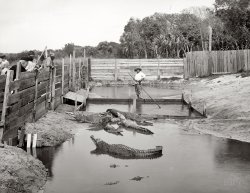
MAY CONTAIN NUTS

Search Shorpy
SHORPY ART

Framed or unframed, desk size to sofa size, printed by us in Arizona and Alabama since 2007. Explore now.
Join and Share
Ad-Free Shorpy
Shorpy is funded by you. Patreon contributors get an ad-free experience.
Learn more.

Recent comments
- Beautiful composition
- Meh
- Amazing house!
- Robie House Roof(s)
- Move to Berlin and SAVE!
- There is an interesting novel set here.
- I Was In Berlin
- Pronunciation
- Shell of a Shell
- Never been there but
- BUR-lin
- Hand-made smokes
- Birthplace of Tupperware, or at least its inventor
- Pulp
- Remarkably unchanged in 84 years
- The church is still there ...
- Talk about a smoke show
- Electric Hansom Cab
- I wondered the same thing.
- The location in 2009
- Pill Pusher
- Roll your own
- Rugged and real!
- Civil War history
- Early EV?
- A Charles Purcell - Mama Cass Connection
- Uncle SAAM
- Obfuscation
- One Chocolate Soldier rode away
- Victor Marquis de la Roche
Member Photos
The Shorpy
Printporium
Printporium
Search Shorpy
Search results -- 30 results per page
- The Busy Corner: 1934
- ... fire. Shame they couldn't save it like they did the Hotel Washington.
A couple of brand-new Fords Two brand-new 1933 or 34 ... Posted by Dave - 08/03/2014 - 9:45am -
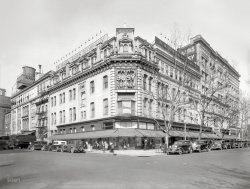
- The Quarter: 1903
- ... came when he choked to death on a bottle cap in a New York hotel on February 24, 1983, a month before his 72nd birthday. Then again, he ... Posted by Dave - 08/21/2012 - 10:50am -
![The Quarter: 1903 New Orleans circa 1903. "Old French courtyard." Shabby chic alfresco. 8x10 inch dry plate glass negative, Detroit Publishing Company. View full size.
Tennesseechoked on an eyedropper-type cap. He was holding the cap in his mouth as he applied the drops.
What on Earth?Not really sure I want to see the front of that infant lefty quarterback with the demonic scaly tail.
Thomas Lanier WilliamsBetter known as Tennessee, would have adored this once-majestic but now decrepit garden and these crumbling buildings as a stage set for his unforgettable, prolific plays, although he wasn't born until 1911.
Ironically, with all his poignant and deeply emotional Southern-flavored stories, his own unexpected end came when he choked to death on a bottle cap in a New York hotel on February 24, 1983, a month before his 72nd birthday. Then again, he probably could have written such an ending for himself, depending on what type of bottle the cap was from. The courtyards of New Orleans are mysterious, and sometimes seem spiritual, mystical, even supernatural. These are the backyards of the Stanley Kowalskis.
Stanley was the real name of his boss in a shoe factory. Personally, I'm partial to the broken bench. What else do you wanna know?
Better than tossing out the windowThose drain pipes by the window seem like a practical solution to a vexing problem. Kind of gross, but better than most alternatives.
WeatheredWow, even over 100 years ago this New Orleans courtyard looked like it had been ravaged by Hurricane Katrina.
WeatherproofingDon't go by the plaster and paint. The plants and walkways are neat and well-tended, the wooden railings aren't broken and shaky, and the glass windows are all intact, with straight, uncracked frames.
We tend to forget the enormous advances that have been made. The climate of New Orleans is extremely destructive to the paints available in that era, and to stucco over brick and unreinforced concrete like the plant borders. The front of this house is probably neatly kempt, even by modern standards, but here in a private space they didn't feel the need to expend the large sums necessary to renew the big plastered wall(s). A view of the same or a similar courtyard today might not look all that different except that the brickwork would be painted, an option not available in 1903 because the available paints wouldn't stick to it.
Water towerslooks like a couple of wooden water towers to the right. Anyone know anything about that?
[The cisterns hold rainwater. - Dave]
RamshackleWhat's curious to me is how that short double level balcony on the left has no supports to it underneath. Seems it wouldn't take too many people at one time on both levels to send them spilling into the garden?! Hope it's been shored up in the intervening 108 years!
Court of the Two SistersI think this might be what is now the "Court of the Two Sisters." The balconies have no supports then or now, as is quite common. The steep pitch shoots the water away from the structure. It was common to have two or three cisterns for a residence up until 1905 when they were outlawed because of concerns over yellow fever. The fountain in the courtyard could have been "run" by one of the cisterns.
[Or: Court of the Two Cisterns. - Dave]
(The Gallery, DPC, New Orleans)](https://www.shorpy.com/files/images/4a10812a.thumbnail.jpg)
- Advanced Vaudeville: 1912
- ... a 104 fever; after the show he returned to the Statler Hotel on Grand Circus Park, where the house doctor diagnosed a ruptured ... Posted by Dave - 08/05/2012 - 10:54am -
![Advanced Vaudeville: 1912 Detroit circa 1912. "Griswold Street from Capitol Park." Home of the Miles Theater and "Advanced Vaudeville" -- you'll laugh, you'll cry, you'll need a slide rule and a thesaurus. 8x10 glass negative, Detroit Publishing. View full size.
Advanced VaudevilleWow--am reading Rick Altman's terrific book "Silent Film Sound" at the moment, so I have just learned that "Advanced Vaudeville" was actually another term for movies c. 1910, or for a vaudeville program combining movies, performers, and illustrated songs. No slide rule required!
I'll biteMr. Gallagher: "Who was that cosine I saw you with last night?"
Mr. Shean: "That was no cosine, that was my tangent."
Some there, most notThe two buildings at right center are still there; the others have been replaced. Capitol Park was converted to an outdoor bus terminal and is nearly all concrete today. I remember waiting for the Grand River streetcar at that location in the 1940s.
Sigh.
Miles to GoThe Miles was demolished in 1927 along with other buildings to its left to make way for the Griswold Building, which was completed in 1929. The theatre switched from vaudeville to movies in the early 1920s. Sources indicate the 1000-seat Miles installed a two-manual, 29-rank Hillgreen-Lane organ at a cost of $9,600 in 1921, which was an unusually large pipe organ for a theatre that size.
The Mayor is dead. Long live the MayorWilliam Richert, mayor of Detroit, died on June 16, 1912. Possibly why the half-staff flags.
[And let's not forget the Titanic. - Dave]
Half-StaffWho was being mourned in Detroit circa 1912?
Relaxing in the parkWhy did we ever give up spaces to relax and read a paper downtown outdoors? We've lost so much with air-conditioned cars and buildings. Maybe I overstate, but this park looks so inviting, and "planned" for pedestrian use. Shops and theaters surround the park. Just a wonderful gathering place. Wish more towns and cities had them centrally located for everyone's benefit.
ProgressFuture additions to the skyline in this view: the mighty Penobscot, the David Stott and the magnificent Guardian Building. Capitol Park has certainly seen a lot of change and is currently being restored to again be pedestrian-friendly.
RE: Relaxing in the parkThe park is still there, but it's a lot less green.
It's still being utilized by people from the looks of it.
As far as thriving shops and theaters...well, there's room to grow!
View Larger Map
Houdini Played HereAs Griswold Street stretches towards Canada and the Detroit River, one can spy the marquee for the Garrick Theater on the left, ... it's in the first block south of Capital Park.
The Garrick was another famous theater in Detroit, and could lay claim as being the last place Houdini performed, Oct. 24, 1926. He took the stage with a 104 fever; after the show he returned to the Statler Hotel on Grand Circus Park, where the house doctor diagnosed a ruptured appendix. He was rushed to Grace Hospital in the early hours of the 25th where he died Oct. 31, 1926.
The Garrick was torn down for the David Stott building in the late 1920s.
Houdini, has not expressed an opinion on the demolition.
Minnie Schoenberg Marxtterrace, did you know that Al Shean was an uncle of the Marx Brothers? His sister, Minnie, was the mother of that incredible group. She tried to turn her boys into a respectable, well-mannered, singing group. Fortunately, she was only minimally successful at that endeavor! I wonder if they played the Miles Theater?
Jeff, thanks for the definition of "Advanced Vaudeville"!
Capitol SquareThis is a recent photo I purchased of the square from the opposite angle. I'm wondering if anyone can date it. You can see it larger at Tattered and Lost Photographs. I'd love to know more about the image.
(The Gallery, Detroit Photos, DPC, Streetcars)](https://www.shorpy.com/files/images/4a24618a.thumbnail.jpg)
- The Athenaeum: 1907
- ... Athens, you will find the name on an Intercontinental hotel.
American Athenaeums (athenaea to the snooty) are private membership ... Posted by Dave - 05/25/2022 - 2:07pm -
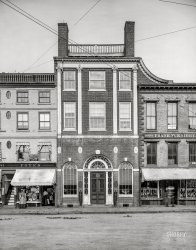
- The Marlborough: 1908
- New York circa 1908. "Hotel Marlborough." On Herald Square at Broadway and West 36th. Among the ... ran often in the Atlanta Constitution around 1900, "The Hotel Marlborough ... is very popular with the southern people ... The rooms ... as much propriety and safety as if she were at the best hotel in her own town."
But a 1923 picture in the NYTimes made it look a ... Posted by Dave - 05/18/2014 - 12:09am -
![The Marlborough: 1908 New York circa 1908. "Hotel Marlborough." On Herald Square at Broadway and West 36th. Among the amenities: A "Ladies' Restaurant." View full size.
Pre-Volstead HostelryOpened in 1888. During the years when Broadway theaters were concentrated south of Times Square, "many of our popular actors made it their home."
"It will go down in history as one of the famous Broadway hostelries of pre-Volstead days ..."
According to an ad that ran often in the Atlanta Constitution around 1900, "The Hotel Marlborough ... is very popular with the southern people ... The rooms are beautifully carpeted in brussels and velvet, while the furniture in them is of the handsomest character...A lady can leave the south and travel all the way to New York and stop at the Marlborough with as much propriety and safety as if she were at the best hotel in her own town."
But a 1923 picture in the NYTimes made it look a bit seedy. A large sign offered "ROOMS WITH BATH $1.50/UP"
In 1923 the building was purchased by A.E. Lefcourt, one of NYC's most prominent developers who erected the Brill Building, among many others.
Lefcourt planned to erect a 20-story office and loft building to cost $3 million for buyers in the women's garment and millinery industry, which apparently had by then replaced the theaters.
A sign you missedLook just above and to the left of the Regal shoes sign. Is that the back side of a Budweiser sign?
Budweiser it isYou are right History_Fan, that is the back of the Anheuser Busch famous "A & Eagle", makers of Budweiser & Michelob. I've found some great beer signs on Shorpy's, some in plain view and others almost invisible. All are a lot of fun to search for.
"Ladies Restaurant"?Is that a restaurant just for ladies or is that the ladies entrance? Either way, it's intriguing.
[It indicated that the establishment was one which respectable women could patronize unescorted without fearing for their safety or reputation. - tterrace]
Schrafft's Also in this picture, on the right, in the row of stores is a Schrafft's Restaurant. It was one of a chain of 8 or so upscale restaurants in NYC. I have a recollection of the one at 13 Street and 5th Avenue in the attached picture. Sometime in the 1950s a friend invited to me to lunch there. It was a hot summer's day and we were in shirtsleeves. They wouldn't let us in without jackets. After some negotiating they supplied jackets for us to wear. They were the ones their waiters wore. The building (in the attachment) later become the Lone Star Cafe which was very popular. The building is located in what could be loosely described as the New School's Parsons Campus. It has become Condominium Apartments.
Beautician Or Nursing Career? From The Trained Nurse & Hospital Review January 1913 via Google Book View
(The Gallery, DPC, NYC)](https://www.shorpy.com/files/images/SHORPY_4a22167a.thumbnail.jpg)
- Bleak House: 1901
- ... City." At Ocean Avenue, George Coryell's Bleak House hotel. View full size.
The Jersey Shore Circa 1901 BK (Before ... was a better book than a brand. Within two years, this hotel reopened under a new name (Hotel Lenox).
What? Not one "Going ... Posted by Dave - 01/03/2019 - 11:06am -
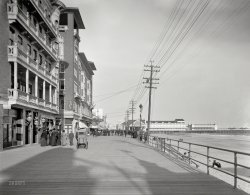
- Reno Ambush: 1958
- ... has survived, but I found a ghost sign for the St. Francis Hotel:
Reno it is https://wnhpc.com/details/photo1014
... Posted by Dave - 02/04/2021 - 4:23pm -
![Reno Ambush: 1958 The latest dispatch from Don Cox is this Kodachrome dated October 1958. Judging by the mayhem on the roof below I'd say we're somewhere in the Wild, Wild West, where the men are men and the Thunderbirds are pink. (Yes, it's Reno. Also: Cash for Cars!) View full size.
Something missingLike maybe a traffic light? Will that T-bird get T-boned?
One more anomaly ...... the lower left No U Turn sign. What's that nearby blue car doing? This pic is full of funny.
[It's making a left turn from East Commercial Row onto Virginia Street, LOL. - Dave]
American GraffitiIf the T-bird was a '57, then that could be Steve and Toad gassing up the '58 Chevy at the Flying A Station. They would be getting ready for cruising tonight and maybe running into Bob Falfa
Cannon NVJudging from the sign for senator Howard W. Cannon, this photo must be from somewhere in Nevada.
But it doesn't look like Las Vegas. Maybe it's Reno?
[Could the arch at lower left be a clue? - Dave]
Look out for the antenna!It's fun to imagine how they had to get their camera angles so as to avoid the TV antenna. And meanwhile downstairs somewhere they were watching the latest episode of Lone Ranger or Cisco Kid (my favorite at the time).
Lots of changesEven the railroad tracks have gone underground. How did the St. Francis survive?
Reno!The photo is showing the corner of Virginia (old 395) and Commercial Row. Not much has survived, but I found a ghost sign for the St. Francis Hotel:
Reno it ishttps://wnhpc.com/details/photo1014
The Colony CasinoThe photo was taken from the tower of Harold's Club looking at the roof of the Colony Casino, which was advertised as being "At the Reno Arch."
[Harold's Club was the robbery target in the 1955 film noir "5 Against the House." - Dave]
Re: traffic lightI don’t even see a stop sign. Gosh, remember when not all city intersections had 4-way stop signs, and there were even some – like maybe this one here – that were uncontrolled intersections, with no stop sign or light, and people simply understood the concept of right of way? Now you’ve got to spell it out at every corner.
[There's a single (presumably blinking) red light visible at each of the other intersections. Perhaps this one was caught between blinks. - Dave]
Cash for Cars ReduxHaving lived in Reno, I often wonder how many people have sold their cars for a bus ticket home and a few more days of gambling. Gambling is everywhere, you'll even find slot machines at the grocery store.
The original Reno ArchThe ornate ironwork in the lower left is the original "RENO -- The Biggest Little City in the World" sign.
That Rooftop MayhemThis article about the Smith family's Harold's Club explains the western scene thusly:
The Smiths, in fact, seemed fascinated with Native Americans, especially those on the attack, and the club's short-lived Fort Smith attraction featured a rooftop tableau of American Indians assailing the fort while soldiers fought them off.
(The Gallery, Kodachromes, Don Cox, Gas Stations, Native Americans, Railroads)](https://www.shorpy.com/files/images/SHORPY-P-0010.thumbnail.jpg)
- Main Street USA: 1912
- Circa 1912. "Main Street and Chippewa Hotel, Mackinac Island, Michigan." 8x10 inch dry plate glass negative, Detroit ... buildings are still there.
The multi-gabled Chippewa Hotel is on the left, still open every summer. At least the first 4 buildings ... Posted by Dave - 07/27/2018 - 1:20pm -
![Main Street USA: 1912 Circa 1912. "Main Street and Chippewa Hotel, Mackinac Island, Michigan." 8x10 inch dry plate glass negative, Detroit Publishing Company. View full size.
+103Below is the same view from August of 2015.
Somewhere in Time!Photo from the very year in which the movie was set.
No luck spotting Elise and Richard, though.
A favorite of the woman who was then my girlfriend, now my wife.
I'd put this earlier than 1912If this were ca. 1912 I think we'd see an automobile or two on the street. Judging by the women's clothes, I'd put it earlier, somewhere 1895-1905.
[You are obviously new to Mackinac Island, famous for being where cars are verboten. Also, count the stars on the flags. There are 48. - Dave]
ColorfulIf this isn't a colorized photo waiting to happen, I don't know what is.
Somewhere elseMackinac Island does feel like it's somewhere (else) in time. It may be because so many of its buildings are still there.
The multi-gabled Chippewa Hotel is on the left, still open every summer. At least the first 4 buildings on the right are still there, but the steeple is gone from the third building.
We remember it fondly because we honeymooned there, well after the season in December; we were the only people in the hotel for a while.
Still smell the horsesNo motorized traffic allowed on Mackinac Island to this day.
What the hackis "bric a brac"?
(The Gallery, DPC, Horses, Stores & Markets)](https://www.shorpy.com/files/images/SHORPY-4a24672a.thumbnail.jpg)
- New Charleston: 1910
- ... Charleston, South Carolina, circa 1910. "New Charleston Hotel and Meeting Street." Close by: a bootery, office supplies and "Shaving ... Posted by Dave - 10/29/2022 - 7:44pm -
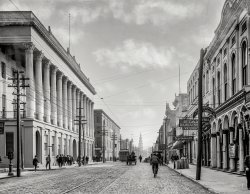
- Well-Connected: 1935
- ... play operator, there are a couple of these in the lobby of Hotel Congress in Tucson, remnants from the Pioneer Hotel down the road.
Hotel Congress still uses its slightly newer 555 ... Posted by Dave - 11/22/2014 - 1:44pm -

- Daytona Beach: 1910
- ... distance would have been parked in front of The Ridgewood Hotel, which was demolished in 1975. The 5-story Brown & Brown building now stands where the old Ridgewood Hotel once stood.
(The Gallery, DPC, Florida) ... Posted by Dave - 07/29/2012 - 6:15pm -
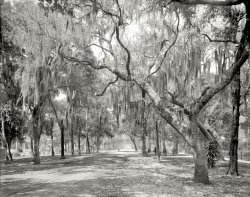
- Lake Worth: 1908
- ... assume the picture was taken on the grounds of the massive hotel in the background, but it's really hard to say which part of Lake Worth ... darky restored to the saddle and his charge again to the hotel.
Waterway Names The reason for different names along the ... Posted by Dave - 08/13/2013 - 3:38pm -
![Lake Worth: 1908 Palm Beach, Florida, circa 1908. "Along the shore of Lake Worth." 8x10 inch dry plate glass negative, Detroit Publishing Company. View full size.
Whew!Having lived in Florida for a spell, I just can't imagine HOW they dealt with the heat having only fans and no A/C. Yet somehow they survived!
[Palm Beach, and Florida in general, was a winter resort. People didn't visit when it was hot. - Dave]
I realize that, I was speaking of life in Florida in general, year-round. It can get to 90 in January :)
ContrastsA straight shoreline and crooked trees.
Geography Palm Beach is a barrier island off the mainland from West Palm Beach. The body of water which separates West Palm Beach and Palm Beach is called Lake Worth; but it is really just part of the Intercoastal Waterway that runs down the length of the coast of Florida from Jacksonville to Miami.
Seems like each segment of the Intercoastal has been given a different name as it runs through different parts of the coast. For example: it's the Halifax River in Daytona Beach; Indian River down near Cape Canaveral; and eventually Biscayne Bay in Miami.
One assume the picture was taken on the grounds of the massive hotel in the background, but it's really hard to say which part of Lake Worth is pictured.
[You are no doubt thinking of the Intracoastal, not "Intercoastal," Waterway. - Dave]
Well, if you Google it, you find that both spelling are used to describe this passageway. I've always heard it called "Intercosstal."
[Google indeed reveals plenty of misspelled words. The waterway in question is the Intracoastal -- meaning along a single coast. Intercoastal would mean connecting two coasts. I was born in Miami and grew up in Florida, and so was well acquainted with the Intracoastal. - Dave]
Adult Perambulators
Farm Journal, November 1905.
No horses are allowed in Palm Beach, — only a lone mule pulling a light summer car along the famous palmetto avenue, from Jake to ocean, … The only other land conveyances are single and double bicycle chairs propelled by liveried colored men at a cost of $1 per hour. These can be seen going in every direction on the paved walks, the jungle trails, and over the long bridge across Lake Worth to West Palm Beach.
The American Scene, 1907,
by Henry James.
It is by means of a light perambulator, of "adult size," but constructed of wicker-work, and pendent from a bicycle propelled by a robust negro, that the jungle is thus visited; the bicycle follows the serpentine track, the secluded ranch is swiftly reached, the peaceful retirement of the cultivators multitudinously admired, the perambulator promptly re-entered, the darky restored to the saddle and his charge again to the hotel.
Waterway NamesThe reason for different names along the Intracoastal Waterway is that the different names were usually there first. The Waterway is a route - like a US Highway route on land, which might run over many roads with different names, but always the same route number. Many parts of the Waterway were originally separate bodies of water that have been linked by man-made canals and channels.
On a different note - why are the trees on the left side of the photo so twisted and the ones on the right side comparatively straighter?
"Intercosstal"As in "between the ribs"?
Landscape architectI think Dr. Seuss must have been in charge of tending the trees on the left side of the walk.
Favorite Bike TrailWhen I lived in WPB I used to ride on the Lake Trail regularly. This is a section of the South Trail with the Flagler mansion in the background.
Palm Beach Lake TrailThe Palm Beach Lake Trail has changed very little in the past 100 years. At the time of the photo the building in the background was the Henry Morrison Flagler home. Today it is the Flagler Museum. The Lake Trail runs some 6 miles almost to the Palm Beach Inlet and is only for pedestrians and bicycles.
(The Gallery, Bicycles, DPC, Florida)](https://www.shorpy.com/files/images/SHORPY_4a23623a.thumbnail.jpg)
- Bustling Brattleboro: 1941
- ... the local birds.
Fireproof! What a selling point!! Hotel Latchis celebrates being a fireproof hotel -- what a different time.
Creative Parking Two 90-degree nose-ins; ... Posted by Dave - 02/13/2019 - 4:13pm -
![Bustling Brattleboro: 1941 July 1941. "The main street in Brattleboro, Vermont." Medium format negative by Jack Delano for the Farm Security Administration. View full size.
Buildings remain - People, not so muchWhat a vibrant town! The same street today is pleasant, but can't match the street in 1941.
Still a going concernThe theater is still operating under the same name.
Lipstick on a ...1938 Ford Standard Fordor dead center. Someone bought the cheapest Ford possible and put whitewall tires on her. Is the ragtop five cars up a Lincoln Continental?
Old stomping groundsBrattleboro was my go-to party town after they raised the drinking age in RI to 19, a month before my 18th birthday. Crash pad, the Molly Stark Motel!
Car Experts --I know there will be a lot of ID comments but help me out on the number two and three on the left, the first with left side fenders showing. Front one I have seen before with those squared headlights, and the one behind with the headlights that look like a pear cut diamond having a "V" (for V-8 let's say) on the left front fender. First time I've noticed a badge on the front fender.
Mystery CarsThe car with the squarish headlights is a 1939 Plymouth, while the one behind it with the teardrop headlights is a 1938 Hudson. The Hudson "V" emblem appearing on the front fender morphed on later models into a red triangle.
[The red triangle is on the Hudson in our photo, at the top of the grille. - Dave]
Nice shineAm really jealous of the deep shine on a few of the cars on the left. It seems I have often owned a car like the one across the street that has been used for target practice by the local birds.
Fireproof! What a selling point!!Hotel Latchis celebrates being a fireproof hotel -- what a different time.
Creative ParkingTwo 90-degree nose-ins; the top one appears to be blocking the truck.
Vehicle IDsFifth car on left is a 1940 Pontiac station wagon with fender-well spare tire. On the far right is a 1934 REO pickup truck and to its rear is a 1934 Auburn. The 1933 model BBV8 Ford in the middle probably started out as a dump truck, now a flatbed with something overhanging the driver's side.
Latchis TheatreAs a five year old boy living in West Townshend, Vermont I would go with my parents for a weekly trip to Brattleboro to buy groceries and other do other shopping.
We went to the movies at the Latchis Theatre on a few occasions. It was very ornate inside ("Greco Deco" according to them) and is still in business today:
https://latchistheatre.com/aboutus/
Road TripDowntown Brattleboro Historic District
Pick up on blusun's Google View and learn the history of this bustling downtown as you go up the street to Amedeo de Angelis.
(The Gallery, Cars, Trucks, Buses, Jack Delano, Movies, Small Towns)](https://www.shorpy.com/files/images/SHORPY-8c06427a.thumbnail.jpg)
- The Monticello: 1902
- Norfolk, Virginia, 1902. "Monticello Hotel, Granby Street and City Hall Avenue." 8x10 inch glass negative by William ... peddler.
Yes, at the start of 1918 The Monticello Hotel burned on New Year's Day 1918. Attempts by firemen to extinguish the ... Posted by Dave - 12/26/2017 - 11:45am -
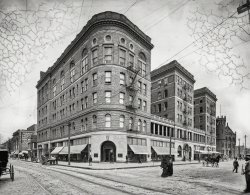
- Needle's Eye: 1943
- ... inverse pagodas are cooling towers, as no decent hotel in a place like Needles could have done any business without some kind of ... would be going to the U.S.O. located inside the El Garces Hotel (Harvey House), which also serves as the passenger train station (it was ... Posted by Dave - 03/01/2014 - 10:14am -
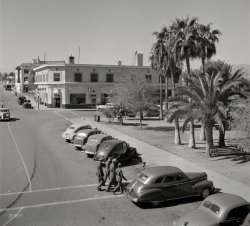
- Memphis Revisited: 1910
- ... Street north from Gayoso Avenue." Our second look at the Hotel Gayoso and flower shop next door. 8x10 inch dry plate glass negative, ... at the time in the original shadow box frame. The old hotel is now upscale apartments.
(The Gallery, Cars, Trucks, Buses, DPC, ... Posted by Dave - 08/14/2012 - 11:39am -
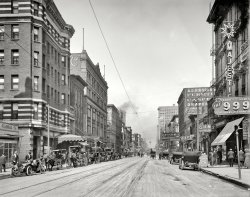
- Confession: 1920
- ... across Olive St, sits the fabulous and historic Biltmore Hotel, definitely something that is on the must-see list if you visit L.A.
... Posted by Dave - 08/09/2012 - 7:16pm -
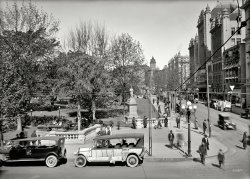
- Society Girls: 1915
- ... a "melange of sprightly nonsense" performed in the Plaza Hotel ballroom on April 15, 1915, and organized by Miss Spence's School Society ... Posted by Dave - 03/09/2012 - 10:36pm -
![Society Girls: 1915 New York circa 1915. "Eleanor Davies -- Marion Gibney -- Emalena Sizer -- Caryl Hackstaff -- Elizabeth Kirlin -- Laura Parsons -- Sophie Young -- Elise Rice (Mrs. Winfield Linn)." 5x7 glass negative, Bain News Service. View full size.
Fairies at the Bottom of our BallroomThese young society women are dressed in their costumes as the Fairy Queen's courtiers in an elaborate amateur musical comedy, "Old King Cole," a "melange of sprightly nonsense" performed in the Plaza Hotel ballroom on April 15, 1915, and organized by Miss Spence's School Society for the benefit of a class of tubercular crippled children. The play, followed by dinner and dancing, was repeated on the evenings of April 16 and 17. A detailed description of the production and its participants was reported in the New York Times.
Society Girlsyet they mold just like commoners.
Follows facial featuresDoes anyone know why the mold lines follow facial features in some cases? That is strange and spooky.
[Mold feeds on photographic emulsion, an organic gelatin compound. The best feeding ground is where the emulsion is thickest, which on a photographic negative are the densest, darkest areas, such as faces. - tterrace]
FinallyDespite the mold lines (because of the mold lines? No.), this is by far the most beautiful group of women ever on Shorpy, by today's standards. I'm not out on a limb here. I'm in on a limb. Way in.
Cleaner complexionsBy way of comparison, the LOC negatives include three individual head shots from this same group portrait, in much better condition than the overall view: The Misses Kirlin and Parsons, and Mrs. Linn.
Missing TagThese young ladies didn't rate the "Pretty Girls" tag? It's not their fault they're so moldy.
[Good point. Fixed! - Dave]
(The Gallery, G.G. Bain, NYC, Pretty Girls)](https://www.shorpy.com/files/images/SHORPY_18936u.thumbnail.jpg)
- Name That Ship!
- ... Volendam (again, 1978-84); Island Sun (floating hotel in Quebec, 1984-85); Liberté (1985-87); Canada Star (1987-89); ... Bermuda Star (1984-90); Enchanted Isle (1990-94); Hotel Commodore (floating hotel in St. Petersburg, Russia, 1994-95);, ... Posted by Jim Page - 09/21/2012 - 9:35pm -
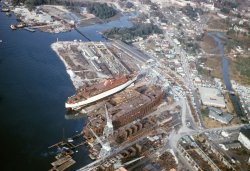
- South Dakota Division: 1899
- ... of fire Check out the fire escape on the side of the hotel in the background.It doesn't look too fireproof itself!
Not Paper ... Posted by Dave - 05/27/2018 - 5:40pm -
![South Dakota Division: 1899 Circa 1899. "Tracy, Minnesota -- engine of the South Dakota division, Chicago & North-Western R.R." Detroit Publishing glass negative. View full size.
Number 605Looks so new it must still have the price sticker on the window. Magnificient detail.
Pressed Paper?Solidly in the link and pin era, the front shank coupler announces this is pre-1900 when such couplers were finally banned.Note the "door" hinged to the side of the headlight. When waiting in a siding, the fireboy went out on the pilot to close the door on the lit headlight so as not to blind the approaching train. This was actually easier than turning out the oil or acetylene lamp. I've seen roller shades used here most often; I can't recall seeing a hinged door before...eh, but those CNW guys could be funny.
Note the headlight mounts are left over from the short smokebox of the engine's original arrangement.Directly below the headlight on the boiler front are two brackets; these were most likely used to brace a pilot-mounted snowplow, necessary equipment in the Plains.
You can almost read the builder's plate date and shop number, but she was built by Schenectady Locomotive Works. Lastly, the front wheels are made of...get this...pressed paper.Look it up, I ain't fibbing![pressed paper railroad wheel]
Schenectady Locomotive Worksthat manufactured C&NW engine #605 operated from 1848 until it merged into American Locomotive Company in 1901. One of the engines it manufactured for C&NW (#1015 in 1900) is still in existence at the Museum of Transportion in Kirkwood, MO.
Actually, locos were kept this clean 'back in the day'>Looks so new it must still have the price sticker on the window.
Although it's possible this was recently out-shopped, it's much more likely it came fresh from the roundhouse. Back in the 19th century, locomotives were kept in pristine condition; railroads hired people to wipe them down and engineers took particular pride in the appearance of their engines.
Olde Buck points out this was most likely converted from wood to coal, I'd guess this loco was constructed in the early 1880s and converted in the late 1880s/1890s.
Note the fixture for a steam line on the roof of the baggage/mail car and the corresponding rig on the back of the tender. There's a steam feed from the steam dome (alongside the whistle). I think this was probably added to the original locomotive.
There's a 'mail bag catcher' on the door for mailbags. I think we've had previous Shorpy photos showing the mail bag hangers alongside a passenger depot.
Magnificent Locomotive!And it's obviously being maintained by a crew that really cares about it. As Olde Buck implies, it is probably not new -- in 1899, the 4-4-0 layout was already considered classic if not obsolescent, and the pin connectors, notoriously dangerous, were being replaced by the "modern" type of couplers. Note the brightly polished bell, the shining surface of the boiler, and other authentic details -- you can see the whistle on top of the steam dome and the lever that triggers it with a lanyard leading back to the cab. The sand dome shows the plumbing that deposits sand on the fore driver wheel as needed for traction.
I don't know how to recognize it in railroad wheels, but it is certainly true pressed paper was used in some, with an iron "tire" on the rim. In the 1880's, pressed paper was even used for the skins of racing shells, as it was lighter than wood. I don't think it is used today for any structural purposes.
In case of fireCheck out the fire escape on the side of the hotel in the background.It doesn't look too fireproof itself!
Not PaperThe pressed paper hubs were strictly used on Pullman Sleepers after
the inventor showed George that they really did reduce vibration transmission.
I could be wrong butI bet it has that new locomotive smell.
During World War Two plastic-reinforced jettisonable paper fuel tanks were used to extend the range of fighter aircraft including the P-47, P-51 and P-38. The largest held 200 gallons, which gave (for example) the P-47 close to a couple more hours of flying time, enough to escort our bombers over Germany. This ability was a very significant contributor to winning the air war because enemy fighters no longer could easily attack the big and unprotected B-17s and B-24s, unprotected except for their many .50 caliber machine guns (some B-17s packed 11 or more), which made many enemy pilots moribund.
Pressed paper wheels> I don't know how to recognize it in railroad wheels, but it is certainly true pressed paper was used in some, with an iron "tire" on the rim.
The give-away is the bolts/rivets on the leading truck wheels. These are typical of composite wheels. A cast wheel would not need these bolts/rivets to hold it together.
Builder's engine DataC&NW 605 was built by Schenectady Locomotive Works in 1885. C&NW labelled it C-2 class. Boiler pressure was 150 lbs. Driving wheels were 63 inches diameter. 605 was scrapped March 5, 1917. 605 weighed 88,500 pounds. Tractive effort was 16,900 lbs. Looks from my source that the railroad had only a dozen C-2 class engines.
A Work In ProgressWhoever was doing the sprucing up must not have had time to finish the tender before the engine was needed for service, because the old, dull finish is visible around and inside its numbers, and on the curved gangway area where the crew climbs up to board.
JugI wonder what beverage was contained in the earthenware jug aft of the engineer.
Second career for a C&NW C-2 4-4-0 - can you help?At least one of these C&NW C-2 class locomotives was sold secondhand. I have a large B&W print of Sheffield & Tionesta #4 at Kelletville, PA in 1904, with no visible builders plate, but "C&NW" cast in the smokebox door just as in 605. S&T #4 was used between 1904 and 1914 as the primary passenger engine on the little S&T, and was replaced by a new Baldwin 4-4-0. The entire railroad was abandoned and sold for scrap in 1941.
Judging by the matching set of dents on the air compressor on the photo I have taken from the same angle, I seriously thought S&T 4 was C&NW 605. If there's any information anyone can find on which one it was, contact me.
Sheffield & Tionesta is convered in the book "Teddy Collins Empire" (Casler, 1974) of the "Logging Railroads of Pennsylvania" series. His book is out of print but the railroad museum of PA has the negatives and original manuscript.
Finding this particular image on Shorpy was wonderful and made me a member.
(The Gallery, DPC, Railroads)](https://www.shorpy.com/files/images/SHORPY-4a04052a1_0.thumbnail.jpg)
- Cafe Society: 1941
- ... re-open a Hot Shoppes in the lobby of hte Marriott Marquis Hotel being built in downtown DC. It should open in 2014.
At least one guy ... Posted by Dave - 11/29/2012 - 9:19pm -
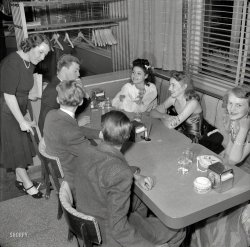
- The Summer of '42
- ... in. Along with the Guardian Building and the Book-Cadillac Hotel, Detroit has such gems more people need to see!
Fisher ... Posted by Dave - 08/13/2012 - 4:35pm -
![The Summer of '42 Detroit, July 1942. "Looking down on a parking lot from the rear of the Fisher Building." 4x5 Kodachrome transparency by Arthur Siegel. View full size.
Deja View all over againIt looks like Deitrich Furs has replaced the billboards, and, if you enlarge the Deja Vu picture, you can virtually stroll down the street with the private dwellings and see that they are now condos. Looks like one block to the north still has old single dwelling homes, however
Cars from this eraLooking at older American cars from this era and even into the 50s and 60s reminds me that SUVs aren't really an aberration, they're more of a return to our roots!
Wartime Parking LotOiled gravel striped with chalk. I remember those.
HousesI know the cars are the point, in a way, but those huge old houses among the trees are a wonderful sight. I wonder how many are left? All the ones where I live have either been torn down or turned into apartments. Hard to believe those were single family dwellings. One would love to fly down and walk those streets under the shady trees.
Deja ViewPoint of reference: the square skylight. Click to zoom.
The Time, The Place And The CarsI suppose you can put the relative absence of older cars down to a couple of things. First this is a pretty major office building (headquarters of Fisher Body) so you'd expect that at least some of the people who work here to be above the norm in terms of affluence; that is more likely to buy newer cars. Then too this is three years after the start of World War II (although only a few months after the US got into the war). Even though, and maybe because, the United States wasn't at war until December 1941, the war in Europe had a big impact on companies like General Motors and its subsidiary Fisher Body. Increased wartime production meant greater competition for workers which meant higher wages which meant that more people were likely to consider a new car purchase than they might have been if the photo had been taken in say 1936. And who knows, maybe the fact that Fisher is a subsidiary of GM meant there'd be a discount available for employees. One things likely - you weren't going to see many Fords, Dodges or Hudsons in THAT parking lot!
[This was an office building financed by the Fisher family with proceeds from the sale of Fisher Body to GM. It was not a General Motors building, and not the headquarters of Fisher Body. - Dave]
How bored was heI am so bored that I count 181 cars in the parking lot and 10 among them that are not turret-topped/not whoosh-windowed/not round-rumped, aka pre-1936ish, so other than those 10, everything there is less than five or six years old. About the same as most parking lots that I park in today, well maybe not. Definitely maybe, almost for sure.
Foy
Las Vegas
Trade-InsInteresting that already in 1942 we see few really old cars in this shot with so many cars captured in it. I see about three or four obviously mid-'thirties cars, and only two possibly late-'twenties or very early-'thirties examples.
Thanks also for the current comparison shot, those are always interesting!
DiveI'm surprised to see the little dive bar in the back of the lot. Can anyone make out the name?
The Fisher Building is one of the most beautiful buildings I've ever been in. Along with the Guardian Building and the Book-Cadillac Hotel, Detroit has such gems more people need to see!
Fisher BuildingI'm sitting at work on the seventh floor of the Fisher Building in Detroit at this very moment!
(The Gallery, Kodachromes, Arthur Siegel, Cars, Trucks, Buses, Detroit Photos)](https://www.shorpy.com/files/images/1a35408u.thumbnail.jpg)
- Pale Rider: 1908
- ... of this general type. The other was in front of the Gotham Hotel a day or so ago. I wonder how many of them were made.
Oh, Say, I Can ... Posted by Dave - 07/24/2012 - 9:51pm -
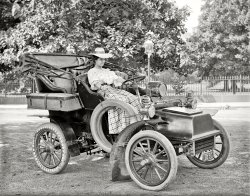
- Bedroom Beautiful: 1956
- ...
It could as easily pass For an upscale motel or hotel room of the era with the acoustical ceiling and recessed lights.
Mid ... Posted by Dave - 03/02/2015 - 1:47am -
![Bedroom Beautiful: 1956 1956. "Hayes residence, Kessler Lake Drive, Dallas. Master bedroom. Architects: Prinz & Brooks." Our first look at the seven-bathroom, 7,300-square-foot bungalow built by Texas car dealer Earl Hayes. 8x10 acetate negative by Maynard L. Parker for House Beautiful. Source: Huntington Library. View full size.
Visual confirmationSo it was true married couples slept in separate beds back in the fifties??
GunsLooks like a gun cabinet over the TV.
[That's a mirror. -tterrace]
Then there's what looks like a bolt-action rifle with scope reflected in the mirror. And I say the dress is white and gold.
Ashtrays on the nightstands even though you're not supposed to smoke in bed. Or maybe so you can stub out your butt before turning in. The footstool offers a comfy place to sit while you fiddle with the TV controls, in those pre-remote days.
2 GunsScoped bolt-action rifle, AND, a pump-action shotgun.
It could as easily passFor an upscale motel or hotel room of the era with the acoustical ceiling and recessed lights.
Mid Century Modernism...at its best. Prinz's own more modest home is a jewel-box, too.
Cold?I don't think so.
Just because it lacks Grandma's gaudy floral patterns and knick knacks all over the place, doesn't make it cold, but it does need to be in color to really see how beautiful it is.
I would change the Peg Board ceiling though.
The TV (note my user name) is a 1956 or 57 RCA, 21" "Transette" model with large casters to allow it to roll out of the cubby for viewing; it looks like it has the Limed Oak finish.
It's still there, and even largerThe house is still there, with a living room addition built in the 1970s. Pocket doors and built-ins are used throughout the house, which was designed for longtime Chevy dealer Earl Hayes. The 7,301 square foot house is at 718 Kessler Lake Drive, in the Kessler Park neighborhood in the Oak Cliff section of Dallas. It was one of the homes featured on the Preservation Dallas tour last fall:
http://www.dallasnews.com/lifestyles/headlines/20141017-3.ece
Humanity leaves its markThen as now, the nagging problems of civilized culture: how to avoid footprints on the shag. (Far superior to telltale vacuum cleaner tracks, though!)
Two or One?My parents always had separate beds. Married in 1944, it was the thing to do, then. I appeared in May of 1946 and have never married, hence for me one bed is adequate.
Cold StorageWow, this has all the warmth of a frozen food locker.
Telescoping pocket doorsare still popular in high-end homes today. If you look at the ceiling you'll see all three sections slide across for the first third of the distance, two for the middle third, and one for the final third.
Lamp on rightMy parents had a couple of lamp bases similar to this one. They were made from obsolete rollers used to print wallpaper. I thought we had the only ones in existence, but it must have been the fashion at the time.
Not a mirrorI believe that's a gun cabinet. Crossed in the opposite direction is a pump shotgun. Neither would reflect this way (bolt handle,and lack of ejection port) in a mirror. It's just smoked glass or a trick of light.
Mystery objectsSomeone please, please tell me: What are those things on the wall above the beds?
[Decor. -tterrace]
(Maynard L. Parker)](https://www.shorpy.com/files/images/hayes-bedroom.thumbnail.jpg)
- Mystery Tent Camp: 1903
- ... about WW2 for those who didn't chose to stay at pricey Hotel del Coronado.
Coronado Island Wandering around the old Hotel Del Coronado in San Diego I saw old photos of a tent city similar to this ... Posted by Dave - 07/12/2014 - 2:17pm -
![Mystery Tent Camp: 1903 Circa 1903. "Striped tents in two rows." This looks a little like California to me. 8x10 inch dry plate glass negative, Detroit Publishing Company. View full size.
Eucalyptus ubiquityIt's amazing how the eucalyptus has spread to every corner of the globe, at least if you go by Hollywood movies of the teens through the fifties. Frex, this frame from Laurel & Hardy's 1933 Fra Diavolo aka The Devil's Brother, a story ostensibly set in Italy.
This link dates the introduction of eucalyptus in California to 1853.
A botanical clueThose trees are eucalyptus, planted as windbreaks perhaps, making it very likely the image was taken in California as you suggest. Hard to believe though the image is from 1903 and not more recently.
It's the gumDuring the Santa Ana winds of October that plague southern California, a spark will turn these trees into perfect torches. They burn very well.
Persistent EucalyptusI've been dealing with eucalyptus trees for about thirty-five years. They're not my favorite tree. Seedlings sprout from roots of parent trees and grow incredibly fast, rapidly spreading beyond their original planted stands and into adjoining natural landscapes.
Eucalyptus trees also get very large very quickly. The trees in this photo might be only 20-30 years old.
Avalon? "In the eucalyptus grove is a tent city where hundreds enjoy camping out with the luxury of perfect neatness and the best of sanitary conditions." From the chapter on Avalon, on Santa Catalina Island, in Charles Frederick Holder, "The Channel Islands of California: a Book for the Angler, Sportsman and Tourist" p 47(1910). The postcards reprinted on page 54 of Marlin Heckman, "Santa Catalina Island in Vintage Postcards (2001), in Google Books, could well be this spot.
Catalina IslandIt sure looks lots like my family's old photos of the tourist camps of Avalon, stripes and all. They were very reasonable to rent and had shared restrooms and shower areas. Daily clean linens were provided, providing more jobs for the industrious locals. They were located on the site of the present Island Plaza, where the bus tours now originate. Coronado here in SD had a similar Tent City up until about WW2 for those who didn't chose to stay at pricey Hotel del Coronado.
Coronado IslandWandering around the old Hotel Del Coronado in San Diego I saw old photos of a tent city similar to this on the strand just south of the hotel, for tourists on a budget. Don't recall if it had a row of eucalyptus down the center, but this is a good excuse to stop by there tomorrow for happy hour and check.
That'll be gum tree to you, mateMy grandma lived in the Sacramento Valley in the 'teens. Her family would move each summer to similar accommodations in the Mendocino hills. The trees were probably a little more redwoody, though.
Big groves of eucalyptus have fallen from favor in California due to the fire hazard. (The Aussies have had huge "bushfires," too.) Still, there are some nice stands here and there.
We used to burn eucalyptus logs (in our LA home in the 1980s) culled from the windbreaks and other lots around the orchards in Ventura County. The wood is pitchy and fast-burning, imagine!
Revival meeting?There are crosses on top of some of the tents.
[Connected by wires! - Dave]
(The Gallery, Camping, DPC)](https://www.shorpy.com/files/images/4a05658a.thumbnail.jpg)
- Boardwalk Empire (Colorized): 1910
- Atlantic City, N.J., circa 1910. "Boardwalk, Hotel Marlborough-Blenheim and Young's Million-Dollar Pier."
Dave posted ... Posted by Dennis Klassen - 11/14/2011 - 3:12pm -

- Free Hot Lunch: 1901
- ... recently) in Las Vegas: you could get a fairly pleasant hotel room cheap, with restaurant meals surprisingly inexpensive. In fact, the ... at a loss in hopes of enticing the guests into the hotel casino -- which raked in enough money to cover everything.
+115 ... Posted by Dave - 08/27/2020 - 4:17pm -
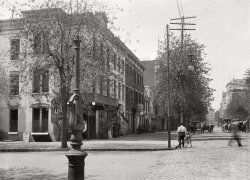
- Palm Beach: 1905
- ... Flagler hotels This trolley led from the the gargantuan Hotel Royal Poinciana about a half mile east to the Breakers on the ocean. ... also choose to take the palm-lined "Ocean Walk."
The hotel closed around 1930 and was razed in 1936. It was the largest wooden ... Posted by Dave - 07/27/2012 - 4:53pm -
![Palm Beach: 1905 Florida circa 1905. "The Palm Beach 'trolley.' " Early development in the Sunshine State. 8x10 inch dry plate glass negative, Detroit Publishing Co. View full size.
Flagler hotelsThis trolley led from the the gargantuan Hotel Royal Poinciana about a half mile east to the Breakers on the ocean. Guests could also choose to take the palm-lined "Ocean Walk."
The hotel closed around 1930 and was razed in 1936. It was the largest wooden structure in the world when it was built.
http://royalpoincianahotel.blogspot.com/
A quibbleis that the term "trolley" refers to the apparatus for picking up electrical power from an overhead wire, absent in this case.
[The word meant "cart." As in horse trolley. It eventually came to be applied to the apparatus drawing electrical current from overhead wires to power a trolley car. Strictly speaking, this conveyance is a horsecar. Which is why the caption puts the word trolley in quotes. - Dave]
JustificationAnother reason I visit Shorpy every day is to give myself a linguistic tuneup.
Trolleys = Go-kartsIn New Zealand (and probably other places) go-karts are "trolleys." There are annual "trolley races" all over. A friend is an organizer for one.
Flagler SystemThe trolley is owned by Henry Flagler's Florida East Coast Railroad. Flagler was the man most responsible for early real estate development and resort building in Florida, bringing all interested parties down there via his own railroad, which ran all the way to Key West, with ferry service to Havana.
HorsepowerWhatever it is, it gets around on 1 HP.
Old FloridaHaving grown up in South Miami, I'm loving this series.
Anyone who attended South Florida schools in the 1960s would know all about Henry Flagler and his railroads and hotels. If I'm ever offered a time machine, my first trip will be to South Florida and the Keys circa 1900. It's wall-to-wall concrete now even compared to when I was a kid, but the pristine, undeveloped wilderness of the area must have been stunning at the time.
(The Gallery, DPC, Florida, Horses, Streetcars)](https://www.shorpy.com/files/images/4a12557a.thumbnail.jpg)
- Down and Out in Omaha: 1938
- ... come back later.
Jake & Elwood The New ***stone Hotel, with its "Clean, Modern Rooms" featuring cracked glass windows and "E-Z Tatter Shades" reminds me of the hotel the Blues Brothers lived in until Carrie Fisher blew it up!
Pressed ... Posted by Dave - 08/02/2017 - 9:21am -
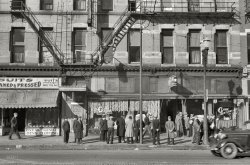
- Alligator Joe: 1904
- ... Company. View full size.
The badge That's a hotel porter's cap. The porters drove (or pushed) guests around in those wicker ... Posted by Dave - 01/06/2013 - 11:51pm -
